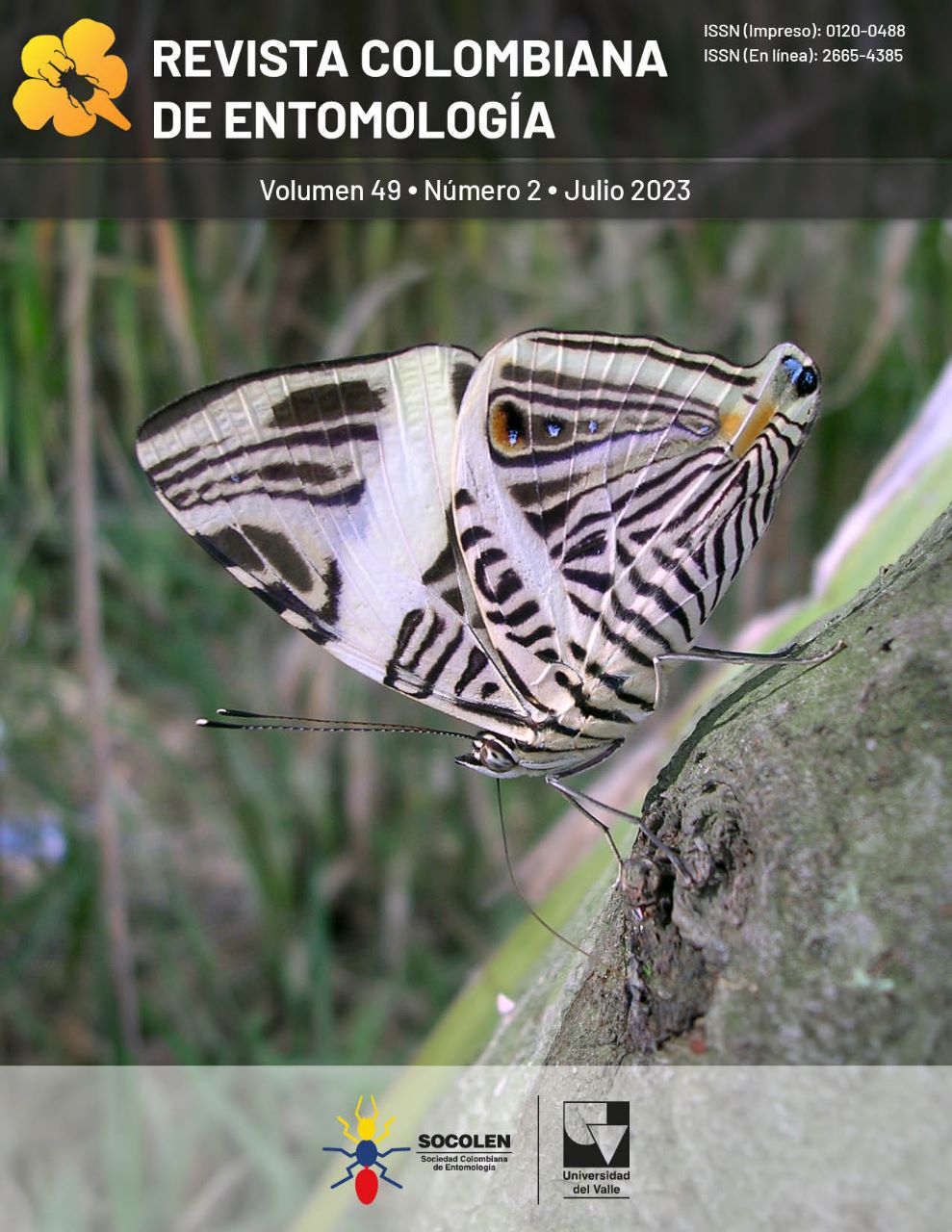Occurrence of natural parasitism in Euschistus heros (Heteroptera: Pentatomidae) eggs by Telenomus sp. aff. podisi in soybean in Amambay, Paraguay
Keywords:
Biological control, brown stink bug, Glycine max, parasitoid, ScelionidaeMain Article Content
Euschistus heros (Hemiptera: Pentatomidae) is the main pest of soybean in Amambay, Paraguay; the intense damage to the pods results in decreased production and economic losses for farmers. Parasitoids that naturally control their populations are important agents to include in integrated pest management. In this investigation, the occurrence of natural parasitism of E. heros eggs by Telenomus sp. aff. podisi (Hymenoptera: Scelionidae) in soybean was determined. The parameters evaluated were: The number of parasitized eggs, parasitism index, and percentage of emerged parasitoids. Photographic images of the parasitoids were also produced to describe their main morphological characteristics. The research was carried out in six districts of the department of Amambay, Paraguay. E. heros eggs were randomly collected from 50 soybean plants, transferred to the laboratory, and conditioned in a climate chamber. After the emergence of the parasitoids, they were placed in a freezer to produce death and in 70 % alcohol for preservation. For the identification of specimens, the parasitoid samples were sent to the laboratory of the Biological Institute of Campinas, Sao Paulo, Brazil. Additionally, photographic images of the recovered adult parasitoids were prepared to describe their main morphological characteristics. Only the parasitoid T. sp. aff. podisi was identified. The number of parasitized eggs was 683, the parasitism index was 92.67 %, and the percentage of emerged parasitoids, was 22.55 %. This is the first report of the natural occurrence of T. sp. aff. Podisi in E. heros eggs in Paraguayan soybean crops, an important biological pest control agent.
Austin, A. D., Johnson, N. F., & Dowton, M. (2005). Systematics, evolution, and biology of scelionid and platygastrid wasps. Annual Review of Entomology, 50(1), 553-583. https://doi.org/10.1146/annurev.ento.50.071803.130500 DOI: https://doi.org/10.1146/annurev.ento.50.071803.130500
Bueno, R. C. O. F., Parra, J. R. P., & Bueno, A. F. (2009). Biological characteristics and thermal requirements of a Brazilian strain of the parasitoid Trichogramma pretiosum reared on eggs of Pseudoplusia includens and Anticarsia gemmatalis. Biology Control, 5(3), 355-361. https://doi.org/10.1016/j.biocontrol.2009.07.006 DOI: https://doi.org/10.1016/j.biocontrol.2009.07.006
Corrêa-Ferreira, B. S. (2002). Trissolcus basalis para o controle de percevejos da soja. En J.R.P. Parra, P.S.M. Botelho, B.S. Corrêa-Ferreira, & J.M. Bento (Eds.), Controle biológico no Brasil: parasitoides e predadores (pp. 449-476). São Paulo, Manole.
Cingolani, M. F., Greco, N. M., & Liljesthröm, G. G. (2014). Parasitismo de huevos de Piezodorus guildinii y Nezara viridula (Hemiptera: Pentatomidae) en soja, alfalfa y trébol rojo. Revista de la Facultad de Ciencias Agrarias UNCuyo, 46(1), 15-27. https://revistas.uncu.edu.ar/ojs/index.php/RFCA/article/view/5626
De Abreu, J. A. S., Rovida, A. F. D. S., & Conte, H. (2015). Controle biológico por insetos parasitoides em culturas agrícolas no Brasil: Revisão de literatura. Uningá Review, 22(2), 22-25. https://revista.uninga.br/uningareviews/article/view/1626
De Freitas Bueno, A., Braz, E. C., Favetti, B. M., França-Neto, J. B., & Silva, G. V. (2020). Release of the egg parasitoid Telenomus podisi to manage the Neotropical Brown Stink Bug, Euschistus heros, in soybean production. Crop Protection, 137, 1-7. https://doi.org/10.1016/j.cropro.2020.105310 DOI: https://doi.org/10.1016/j.cropro.2020.105310
Fernández, F. (2000). Sistemática y filogenia de los himenópteros de la región Neotropical: estado de conocimiento y perspectivas. En F. Martín-Piera, J.J. Morrone & A. Melic (Eds.), Inventario y Estimación de la Diversidad Entomológica en Iberoamérica: PrIBES-2000. (3th Ed., pp. 211-232), SEA, Zaragoza.
Ferreira-Agüero, M.A., De Vilhena-Dios, R., & Orzuza-Escobar, D. (2018). Primer registro de Gymnoclytia (Diptera: Tachinidae) endoparasitoide de Euschistus heros (Hemiptera: Pentatomidae) en Paraguay. Revista Colombiana de Entomología, 44(1), 138-140. https://doi.org/10.25100/socolen.v44i1.6553 DOI: https://doi.org/10.25100/socolen.v44i1.6553
Johnson, N. F. (1992). Catalog of world species of Proctotrupoidea, exclusive of Platygastridae (Hymenoptera). Memórias do Instituto Entomológico Americano, 51, 1-825. https://cir.nii.ac.jp/crid/1572261549971068672
Johnson N. F. (1984). Systematics of Nearctic Telenomus: classification and revisions of the podisi and phymatae species groups (Hymenoptera: Scelionidae). Bulletin of the Ohio Biological Survey, 6(3), 1-13. https://www.cabdirect.org/cabdirect/abstract/19850529768
Masner, L. (1993). Superfamily Platygastroidea. En H. Goulet & J.T. Huber (Eds.), Hymenoptera of the World: An identification guide to families (pp. 558-565). Agriculture Canada Publications, Ottawa, Canadá. https://d1ied5g1xfgpx8.cloudfront.net/pdfs/35617.pdf
Masner, L. (1980). Key to genera of Scelionidae of the Holarctic region, with descriptions of new genera and species (Hymenoptera: Proctotrupoidea). Memoirs of the Entomological Society of Canada, (S113), 1-54. https://doi.org/10.4039/entm112113fv DOI: https://doi.org/10.4039/entm112113fv
Masner, L., & Arias-Penna, T. M. (2006). Familia Scelionidae. En F. Fernández & M.J. Sharkey (Eds.), Hymenoptera de la Región Neotropical (pp. 775-784), Memoirs of the American Entomological Institute.
Pernambuco Filho, J. C. A., Almeida, W. S. M., Gladenuccí, J., Zachrisson, B., & De Oliveira, R. C. (2022). Efficacy of Telenomus podisi Ashmead, 1893 (Hymenoptera: Platygastridae) release for the control of Euschistus heros (Fabricius, 1794) (Hemiptera: Pentatomidae) eggs in soybean, in Brazil. Idesia (Arica), 40(1), 77-86. https://dx.doi.org/10.4067/S0718-34292022000100077 DOI: https://doi.org/10.4067/S0718-34292022000100077
Ramirez-Ahuja, M. L., Davila-Barboza, J. A., Talamas, E. J., Moore, M. R., Bobadilla-Utrera, C., Ponce-Garcia, G., & Flores, A. E. (2021). First record of Telenomus fariai Costa Lima, 1927 (Hymenoptera, Scelionidae, Telenominae) as a parasitoid of Triatoma dimidiata (Latreille, 1811) (Hemiptera, Reduviidae, Triatominae) eggs in Mexico. Journal of Hymenoptera Research, 87, 309-322. https://doi.org/10.3897/jhr.87.73546 DOI: https://doi.org/10.3897/jhr.87.73546
Talamas, E. J., Johnson, N. F., & Buffingto, M. (2015). Key to Nearctic species of Trissolcus Ashmead (Hymenoptera, Scelionidae), natural enemies of native and invasive stink bugs (Hemiptera, Pentatomidae). Journal of Hymenoptera Research, 43, 45-110. https://doi.org/10.3897/JHR.43.8560 DOI: https://doi.org/10.3897/JHR.43.8560
Wengrat, A. P. G. S. (2022). Uma abordagem taxonômica integrativa para o conhecimento da diversidade de parasitoides de ovos (Hymenoptera: Scelionidae) na cultura da soja sob diferentes manejos. [Tesis de Doctorado, Escola Superior de Agricultura Luiz de Queiroz, Universidade de São Paulo, Piracicaba]. https://repositorio.usp.br/item/003090458
Zachrisson, B., Valmir, C., & Bernal, J. (2014). Incidencia natural de parasitoides de huevos de Oebalus insularis Stal (Heteroptera: Pentatomidae) en Panamá. Idesia (Arica), 32(2), 119-121. https://dx.doi.org/10.4067/S0718-34292014000200016 DOI: https://doi.org/10.4067/S0718-34292014000200016
Downloads

This work is licensed under a Creative Commons Attribution-NonCommercial-ShareAlike 4.0 International License.
Authors retain the copyright on their work and are responsible for the ideas expressed in them. Once a manuscript is approved for publication, authors are asked for a publication license for the term of legal protection, for all territories that allows the use, dissemination and disclosure of the same.

